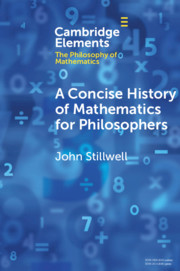Element contents
A Concise History of Mathematics for Philosophers
Published online by Cambridge University Press: 06 June 2019
Summary
Keywords
- Type
- Element
- Information
- Online ISBN: 9781108610124Publisher: Cambridge University PressPrint publication: 06 June 2019
Bibliography
- 14
- Cited by



